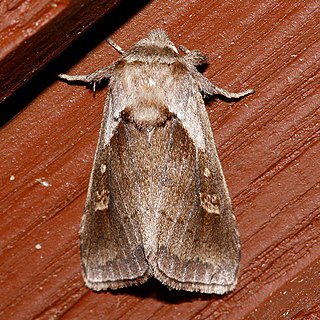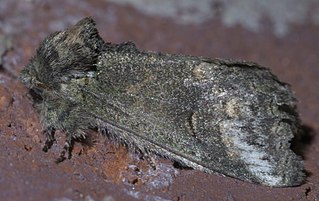
Heterocampa obliqua, the oblique heterocampa or oblique prominent, is a species of moth in the family Notodontidae. It was first described by Alpheus Spring Packard in 1864 and it is found in North America.

Heterocampa astarte, the astarte prominent moth, is a species of moth in the family Notodontidae. It was first described by Edward Doubleday in 1841 and it is found in North America.

Bellura obliqua, the cattail borer, is a species of cutworm or dart moth in the family Noctuidae. It was first described by Francis Walker in 1865 and it is found in North America.
Heterocampa ruficornis is a species of moth in the family Notodontidae. It was first described by Harrison Gray Dyar Jr. in 1905 and it is found in North America.
Heterocampa benitensis, the spring snowflake, is a species of moth in the family Notodontidae. It was first described by André Blanchard in 1971 and it is found in North America.

Odontosia elegans, the elegant prominent, is a species of moth in the family Notodontidae. It was first described by Herman Strecker in 1885 and it is found in North America.
Hyparpax aurostriata is a species of moth in the family Notodontidae. It was first described by Graef in 1888 and it is found in North America.
Heterocampa amanda is a species of moth in the family Notodontidae. It was first described by William Barnes and Arthur Ward Lindsey in 1921 and it is found in North America.
Notodonta pacifica is a species of moth in the family Notodontidae. It was first described by Hans Hermann Behr in 1892 and it is found in North America.

Peridea basitriens, the oval-based prominent, is a species of moth in the family Notodontidae. It was first described by Francis Walker in 1855 and it is found in North America.
Acronicta dolli, or Doll's dagger moth, is a species of moth in the family Noctuidae. It was first described by William Barnes and James Halliday McDunnough in 1818 and it is found in North America.

Cecrita lunata is a species of moth in the family Notodontidae. It was first described by Henry Edwards in 1884 and it is found in the western United States and Mexico.

Eudocima serpentifera is a species of fruit-piercing moth in the family Erebidae first described by Francis Walker in 1858. It is found in North America.
Heterocampa varia, the sandplain heterocampa, is a species of moth in the family Notodontidae. Other common names include the alpine mouse-ear and white-marked heterocampa. It was first described by Francis Walker in 1855 and it is found in North America.

Heterocampa biundata, the wavy-lined heterocampa, is a species of moth in the family Notodontidae. It was first described by Francis Walker in 1855 and it is found in North America.
Heterocampa zayasi, the blue moor-grass moth or zaya heterocampa, is a species of moth in the family Notodontidae. It was first described by Torre and Alayo in 1959 and it is found in Cuba.

Heterocampa subrotata, the small heterocampa, is a species of moth in the family Notodontidae. It was first described by Leon F. Harvey in 1874 and it is found in North America.
Lacinipolia aileenae is a moth genus or species of cutworm or dart moth in the family Noctuidae. It is found in North America.
Cecrita belfragei is a species of moth in the family Notodontidae. It was first described by Augustus Radcliffe Grote in 1879 and it is found in North America.
Heterocampa incongrua is a species of moth in the family Notodontidae. It was first described by William Barnes and Foster Hendrickson Benjamin in 1924 and it is found in North America.








